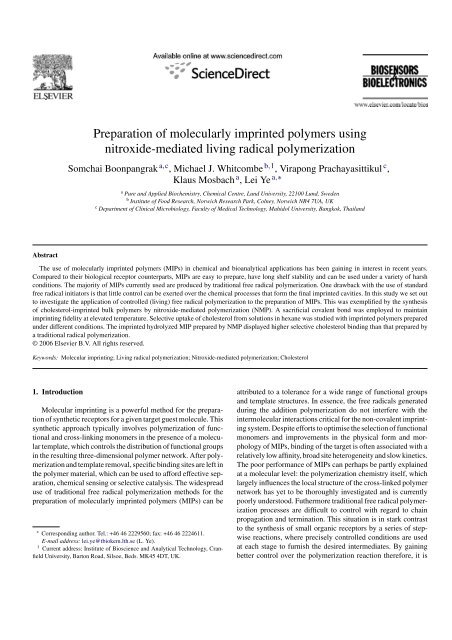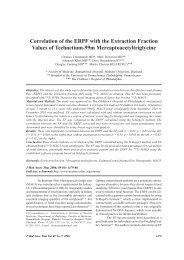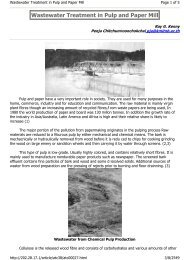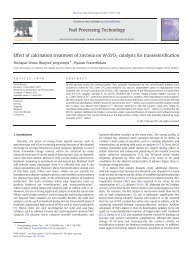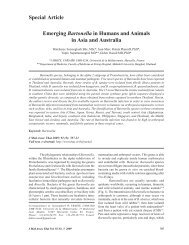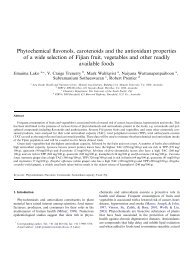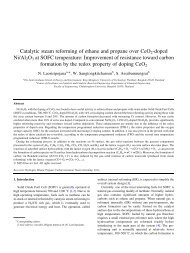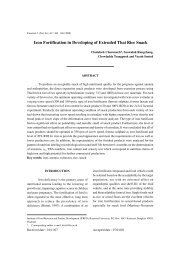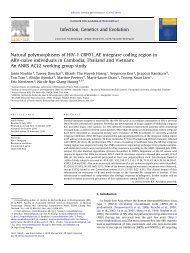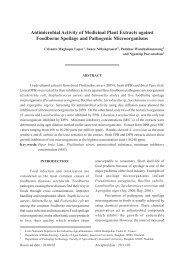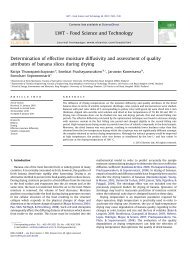Preparation of molecularly imprinted polymers using ... - ThaiScience
Preparation of molecularly imprinted polymers using ... - ThaiScience
Preparation of molecularly imprinted polymers using ... - ThaiScience
Create successful ePaper yourself
Turn your PDF publications into a flip-book with our unique Google optimized e-Paper software.
Abstract<br />
<strong>Preparation</strong> <strong>of</strong> <strong>molecularly</strong> <strong>imprinted</strong> <strong>polymers</strong> <strong>using</strong><br />
nitroxide-mediated living radical polymerization<br />
Somchai Boonpangrak a,c , Michael J. Whitcombe b,1 , Virapong Prachayasittikul c ,<br />
Klaus Mosbach a , Lei Ye a,∗<br />
a Pure and Applied Biochemistry, Chemical Centre, Lund University, 22100 Lund, Sweden<br />
b Institute <strong>of</strong> Food Research, Norwich Research Park, Colney, Norwich NR4 7UA, UK<br />
c Department <strong>of</strong> Clinical Microbiology, Faculty <strong>of</strong> Medical Technology, Mahidol University, Bangkok, Thailand<br />
The use <strong>of</strong> <strong>molecularly</strong> <strong>imprinted</strong> <strong>polymers</strong> (MIPs) in chemical and bioanalytical applications has been gaining in interest in recent years.<br />
Compared to their biological receptor counterparts, MIPs are easy to prepare, have long shelf stability and can be used under a variety <strong>of</strong> harsh<br />
conditions. The majority <strong>of</strong> MIPs currently used are produced by traditional free radical polymerization. One drawback with the use <strong>of</strong> standard<br />
free radical initiators is that little control can be exerted over the chemical processes that form the final <strong>imprinted</strong> cavities. In this study we set out<br />
to investigate the application <strong>of</strong> controlled (living) free radical polymerization to the preparation <strong>of</strong> MIPs. This was exemplified by the synthesis<br />
<strong>of</strong> cholesterol-<strong>imprinted</strong> bulk <strong>polymers</strong> by nitroxide-mediated polymerization (NMP). A sacrificial covalent bond was employed to maintain<br />
imprinting fidelity at elevated temperature. Selective uptake <strong>of</strong> cholesterol from solutions in hexane was studied with <strong>imprinted</strong> <strong>polymers</strong> prepared<br />
under different conditions. The <strong>imprinted</strong> hydrolyzed MIP prepared by NMP displayed higher selective cholesterol binding than that prepared by<br />
a traditional radical polymerization.<br />
© 2006 Elsevier B.V. All rights reserved.<br />
Keywords: Molecular imprinting; Living radical polymerization; Nitroxide-mediated polymerization; Cholesterol<br />
1. Introduction<br />
Molecular imprinting is a powerful method for the preparation<br />
<strong>of</strong> synthetic receptors for a given target guest molecule. This<br />
synthetic approach typically involves polymerization <strong>of</strong> functional<br />
and cross-linking monomers in the presence <strong>of</strong> a molecular<br />
template, which controls the distribution <strong>of</strong> functional groups<br />
in the resulting three-dimensional polymer network. After polymerization<br />
and template removal, specific binding sites are left in<br />
the polymer material, which can be used to afford effective separation,<br />
chemical sensing or selective catalysis. The widespread<br />
use <strong>of</strong> traditional free radical polymerization methods for the<br />
preparation <strong>of</strong> <strong>molecularly</strong> <strong>imprinted</strong> <strong>polymers</strong> (MIPs) can be<br />
∗ Corresponding author. Tel.: +46 46 2229560; fax: +46 46 2224611.<br />
E-mail address: lei.ye@tbiokem.lth.se (L. Ye).<br />
1 Current address: Institute <strong>of</strong> Bioscience and Analytical Technology, Cranfield<br />
University, Barton Road, Silsoe, Beds. MK45 4DT, UK.<br />
attributed to a tolerance for a wide range <strong>of</strong> functional groups<br />
and template structures. In essence, the free radicals generated<br />
during the addition polymerization do not interfere with the<br />
intermolecular interactions critical for the non-covalent imprinting<br />
system. Despite efforts to optimise the selection <strong>of</strong> functional<br />
monomers and improvements in the physical form and morphology<br />
<strong>of</strong> MIPs, binding <strong>of</strong> the target is <strong>of</strong>ten associated with a<br />
relatively low affinity, broad site heterogeneity and slow kinetics.<br />
The poor performance <strong>of</strong> MIPs can perhaps be partly explained<br />
at a molecular level: the polymerization chemistry itself, which<br />
largely influences the local structure <strong>of</strong> the cross-linked polymer<br />
network has yet to be thoroughly investigated and is currently<br />
poorly understood. Futhermore traditional free radical polymerization<br />
processes are difficult to control with regard to chain<br />
propagation and termination. This situation is in stark contrast<br />
to the synthesis <strong>of</strong> small organic receptors by a series <strong>of</strong> stepwise<br />
reactions, where precisely controlled conditions are used<br />
at each stage to furnish the desired intermediates. By gaining<br />
better control over the polymerization reaction therefore, it is
expected that improved molecular recognition with MIPs can<br />
be achieved.<br />
Recently, Zimmerman and co-workers used metal-catalyzed<br />
ring-closing metathesis polymerization to prepare mono<strong>molecularly</strong><br />
<strong>imprinted</strong> dendrimers, in which a porphyrin binding site<br />
was formed by cross-linking <strong>of</strong> the peripheral vinyl groups<br />
(Zimmerman et al., 2002). Steinke and co-workers used ringopening<br />
metathesis polymerization to prepare bulk <strong>polymers</strong><br />
that displayed chiral-selective binding for l- and d-menthol<br />
(Patel et al., 2003). The use <strong>of</strong> the special catalysts in these studies<br />
required that a covalent imprinting – non-covalent binding<br />
strategy be adopted.<br />
Research on living radical polymerization systems has<br />
resulted in significant advancement in the methodology during<br />
recent years. The problematic chain termination encountered<br />
in traditional addition polymerization can be minimized when<br />
<strong>using</strong> living radical initiators, resulting in a more constant rate<br />
for polymer chain growth, and a narrow molecular weight distribution<br />
for linear (non cross-linked) <strong>polymers</strong>. Living radical<br />
polymerization has so far been mainly used to synthesize noncross-linked<br />
<strong>polymers</strong> with different terminal functional groups.<br />
The application <strong>of</strong> living radical polymerization to cross-linked<br />
systems has been little studied. Among the most feasible living<br />
radical polymerization methods, only atom-transfer radical<br />
polymerization (ATRP) (Matyjaszewski and Xia, 2001) has been<br />
used to prepare MIPs in a non-covalent imprinting system (Wei<br />
et al., 2005). The other living radical polymerization methods,<br />
i.e. reversible association fragmentation polymerization (RAFT)<br />
(Chiefari et al., 1998) and nitroxide-mediated polymerization<br />
(NMP) (Benoit et al., 1999) have not so far been used for MIP<br />
preparation.<br />
The present work was aimed at studying nitroxide-mediated<br />
polymerization for the preparation <strong>of</strong> <strong>molecularly</strong> <strong>imprinted</strong><br />
<strong>polymers</strong>. We were particularly interested in NMP because it<br />
does not require any additional catalyst or chain transfer reagent:<br />
a single NMP initiator is sufficient to achieve reaction control.<br />
In addition, NMP can also simplify surface modification<br />
for MIPs to bring about better compatibility with different solvent<br />
systems. Furthermore, NMP has the potential to be used<br />
in both covalent and non-covalent imprinting systems, given<br />
that new low temperature NMP initiators are being developed<br />
(Hintermann et al., 2002). In the present study we used a nitroxide<br />
reagent that requires a relatively high activation temperature<br />
Table 1<br />
<strong>Preparation</strong> and characterization <strong>of</strong> <strong>molecularly</strong> <strong>imprinted</strong> <strong>polymers</strong><br />
(125 ◦ C). To maintain stable functional monomer – template<br />
complexation under these conditions, we selected to adopt the<br />
sacrificial spacer method in which the cholesterol template<br />
remains covalently bound to a monomer during its copolymerization<br />
with cross-linker (Whitcombe et al., 1995). After<br />
polymerization and template removal by hydrolytic cleavage,<br />
the resulting MIP contained specific binding sites that could<br />
take up cholesterol via non-covalent hydrogen bond interaction<br />
in a non-polar solvent. The binding performance <strong>of</strong> the MIP prepared<br />
by NMP was compared to that prepared with a traditional<br />
radical polymerization initiator.<br />
2. Experimental<br />
2.1. Materials<br />
Divinylbenzene (DVB, technical, mixture <strong>of</strong> isomers, 80%),<br />
4-tert-butylstyrene (TBS, 93%), 2,2,6,6-tetramethyl-1-piperidinyloxy<br />
(TEMPO, 99%), 2,2 ′ -azobisisobutyronitrile (AIBN,<br />
98%), benzoyl peroxide (BPO, 75%), 4-acetoxystyrene (96%),<br />
cholesteryl chlor<strong>of</strong>ormate (98%) and m-xylene (anhydrous,<br />
99+%) were purchased from Aldrich. TBS was purified by<br />
vacuum distillation. AIBN and BPO were purified by recrystallization<br />
from methanol. Prior to use, DVB was passed<br />
through an aluminium oxide column to remove the stabilizer,<br />
4-tert-butylcatechol. [1,2- 3 H(N)]cholesterol (specific activity<br />
41.3 Ci mmol −1 ) was supplied by Sigma. Scintillation liquid,<br />
Ecoscint A, was from National Diagnostics (Atlanta, GA,<br />
USA). The NMP initiator, 3-(4-tert-butylphenyl)-1,1-dimethyl-<br />
3-(2,2,6,6-tetramethylpiperidinooxy)propyl cyanide (1), was<br />
synthesized <strong>using</strong> a literature method (Abrol et al., 1997).<br />
Cholesteryl (4-vinyl)phenyl carbonate was synthesized following<br />
the published protocol (Whitcombe et al., 1995). Other<br />
solvents and reagents were <strong>of</strong> analytical grade unless otherwise<br />
stated. Elemental analysis for oxygen content was performed by<br />
MikroKemi AB, Uppsala, Sweden.<br />
2.2. Polymer preparation<br />
Cholesterol-<strong>imprinted</strong> <strong>polymers</strong> (MIP) and non-<strong>imprinted</strong><br />
<strong>polymers</strong> (NIP) were prepared <strong>using</strong> either the NMP reagent<br />
1 or BPO as initiator (Table 1). The monomers and initiator<br />
were dissolved in 0.88 mL <strong>of</strong> m-xylene, the solution was purged<br />
Polymer Initiator Monomer (mmol) Hydrolysis BET surface<br />
treatment area (m2 g−1 O content High affinity sites Low affinity sites<br />
2 DVB<br />
) (%)<br />
KD (M) Bmax<br />
(nmol g−1 )<br />
KD (mM) Bmax<br />
(mol g−1 )<br />
MIP(NMP) 1 0.29 5.51 No 470 1.1<br />
MIP(NMP)-H 1 0.29 5.51 Yes 621 0.4 4.5 ± 1.2 a 61 ± 15 31 ± 5.4 33 ± 5.6<br />
NIP(NMP)-H 1 0 5.81 Yes 705 n.d. b<br />
MIP(BPO) BPO 0.29 5.51 No 571 1.2<br />
MIP(BPO)-H BPO 0.29 5.51 Yes 730 0.8 8.1 ± 2.5 73 ± 22 12 ± 2.6 84 ± 18<br />
NIP(BPO)-H BPO 0 5.81 Yes 789 n.d.<br />
a Standard error <strong>of</strong> the linear regression.<br />
b n.d.: not determined.
with a gentle flow <strong>of</strong> Ar for 5 min. Thereafter, the reaction mixture<br />
was heated in an oil bath to 125 ◦ C and kept for 48 h.<br />
After polymerization, the polymer monolith was crushed into<br />
small particles, washed with methanol, hexane, and dried in a<br />
vacuum chamber. To remove the covalently linked cholesterol,<br />
half <strong>of</strong> the <strong>imprinted</strong> <strong>polymers</strong> were refluxed in 20 mL <strong>of</strong> 1 M<br />
NaOH in methanol for 48 h. After neutralization with 1 M HCl,<br />
polymer particles were collected by centrifugation, washed with<br />
methanol, hexane, and dried in a vacuum chamber. For comparison,<br />
the non-<strong>imprinted</strong> <strong>polymers</strong> were subjected to the same<br />
hydrolysis treatment.<br />
2.3. Equilibrium binding analysis<br />
Polymer particles were incubated in 1 mL <strong>of</strong> [1,2-<br />
3 H(N)]cholesterol solution in hexane (1.4 nM), with and without<br />
Fig. 1. <strong>Preparation</strong> <strong>of</strong> cholesterol-<strong>imprinted</strong> polymer <strong>using</strong> nitroxide-mediated polymerization. The transient free radicals generated from 1 (Step 1) initiate chain<br />
polymerization <strong>of</strong> 2 and DVB (Step 2). The majority <strong>of</strong> the growing chain radicals are stabilized by their reversible association with TEMPO (Step 3), so that<br />
permanent chain termination is avoided. This living polymerization finally leads to the formation <strong>of</strong> <strong>imprinted</strong> sites in the cross-linked polymer network (Step 4),<br />
which after hydrolysis (Step 5) afford specific cholesterol binding cavities.
addition <strong>of</strong> non-labelled cholesterol, at 20 ◦ C for 16 h. A rocking<br />
table was used to provide gentle mixing. After incubation, samples<br />
were centrifuged to sediment polymer particles. A fraction<br />
<strong>of</strong> the supernatant (200 L) was taken and mixed with scintillation<br />
liquid Ecosint A (10 mL), and counted for 1 min in a<br />
Rackbeta 2119 liquid scintillation counter (LKB Wallac, Sollentuna,<br />
SE). The liquid counting results were used to calculate<br />
the percentage <strong>of</strong> [1,2- 3 H(N)]cholesterol that bound to the<br />
<strong>polymers</strong>.<br />
3. Results and discussion<br />
3.1. Polymerization systems for preparation <strong>of</strong><br />
cholesterol-<strong>imprinted</strong> <strong>polymers</strong><br />
In the present study we prepared cholesterol-<strong>imprinted</strong> <strong>polymers</strong><br />
<strong>using</strong> a template-monomer conjugate containing the sacrificial<br />
carbonate spacer. The template-monomer conjugate was<br />
originally designed to prepare <strong>imprinted</strong> polyacrylate-type <strong>polymers</strong>,<br />
which showed highly selective cholesterol binding in a<br />
non-polar organic solvent (Whitcombe et al., 1995). With the<br />
present nitroxide-mediated reaction system, a relatively high<br />
temperature was required to activate the TEMPO-capped dormant<br />
radicals (Fig. 1). The polymer chain growth and crosslinking<br />
can be easily stopped or re-initiated by simply changing<br />
reaction temperature. The polymerization <strong>using</strong> NMP reagent<br />
1 turned out to be much slower compared to that <strong>using</strong> BPO<br />
as initiator. The NMP system did not reach gelation point after<br />
16 h reaction, whereas the BPO-initiated mixture changed into<br />
an amorphous solid within 20 min at 125 ◦ C. The slow polymerization<br />
rate for the NMP system can be explained by the<br />
reversible association <strong>of</strong> the TEMPO with the growing chain<br />
radicals. We expected this to allow the growing polymer chain<br />
to adopt a microscopic structure different from that obtained with<br />
the traditional BPO initiator. The NMP reaction process involves<br />
reversible capping <strong>of</strong> the chain radicals by the TEMPO moiety<br />
to prevent early termination. The NMP <strong>of</strong> the imprinting system<br />
is therefore under a certain level <strong>of</strong> thermodynamic control. In<br />
the BPO initiated system, chain propagation stopped within a<br />
very short time due to termination reactions, which were in turn<br />
caused by the high free radical concentration during the initial<br />
stages <strong>of</strong> polymerization. In a sense the polymer network was<br />
formed without allowing any opportunity for self-optimization,<br />
and the imprinting process was predominantly under kinetic control.<br />
Indeed, the cross-linked <strong>polymers</strong> prepared <strong>using</strong> the two<br />
initiators had rather different surface area, i.e. the BPO initiated<br />
polymer had a surface area about 20% higher than the NMP<br />
polymer (Table 1).<br />
The cholesterol template was removed by hydrolytic treatment<br />
after polymerization. The use <strong>of</strong> DVB as cross-linker<br />
allowed us to use rather harsh conditions to maximize template<br />
cleavage. Despite <strong>of</strong> the difference in polymerization<br />
mechanisms, the hydrolysis treatment resulted in an increase<br />
in the surface area <strong>of</strong> both <strong>imprinted</strong> <strong>polymers</strong> <strong>of</strong> about 30%<br />
(Table 1), suggesting that the hydrolysis treatment had similar<br />
morphological effects in the two polymer systems. The template<br />
loading in the present preparation was only 5%, meaning that<br />
template removal should not affect surface area significantly.<br />
Table 1 also listed the surface areas measured on the non<strong>imprinted</strong><br />
hydrolyzed <strong>polymers</strong> (NIP(NMP)-H and NIP(BPO)-<br />
H). As seen, these samples had the highest surface areas even<br />
though no template could be removed from the polymer matrices.<br />
A comparison <strong>of</strong> the oxygen content before and after<br />
hydrolysis gave a rough measure <strong>of</strong> the efficiency <strong>of</strong> template<br />
removal, for MIP(NMP) a decrease <strong>of</strong> 64% was recorded,<br />
whereas the oxygen content <strong>of</strong> MIP(BPO) decreased by only<br />
33% (Table 1). This indicated that removal <strong>of</strong> the cholesterol<br />
template from MIP(NMP) was much more easily achieved, even<br />
though MIP(BPO) possessed a larger surface area. The different<br />
accessibility <strong>of</strong> the <strong>imprinted</strong> sites in MIP(NMP) and MIP(BPO)<br />
may be a consequence <strong>of</strong> the different reaction mechanisms<br />
involved in their respective polymerizations.<br />
3.2. Equilibrium binding analysis<br />
The <strong>imprinted</strong> unhydrolyzed <strong>polymers</strong> were used as control<br />
samples to measure non-specific cholesterol adsorption<br />
outside the cavities. The two <strong>imprinted</strong> hydrolyzed <strong>polymers</strong><br />
(MIP(NMP)-H and MIP(BPO)-H) bound much more cholesterol<br />
than the corresponding <strong>imprinted</strong> un-hydrolyzed <strong>polymers</strong><br />
(MIP(NMP) and MIP(BPO)) from a dilute solution in hexane<br />
(Fig. 2). The difference in cholesterol binding before and after<br />
hydrolysis indicated that the <strong>imprinted</strong> sites had much higher<br />
cholesterol affinity, resulting from a combination <strong>of</strong> hydrogenbond<br />
interaction and the complementary fit <strong>of</strong> cholesterol in<br />
the cavities. The change in surface area caused by the hydrolysis<br />
treatment may affect cholesterol binding in hexane as well.<br />
To compensate for this effect, two DVB homo<strong>polymers</strong>, prepared<br />
<strong>using</strong> NMP and BPO initiation, were subjected to the<br />
same hydrolysis conditions and used as additional controls.<br />
Fig. 2 shows that the non-specific cholesterol binding to these<br />
<strong>polymers</strong> was slightly higher than that seen with MIP(NMP)<br />
and MIP(BPO). However, cholesterol binding in the specific<br />
cavities <strong>of</strong> the two <strong>imprinted</strong> hydrolyzed <strong>polymers</strong> was still<br />
predominant.<br />
Fig. 2. Uptake <strong>of</strong> [ 3 H]cholesterol by MIP(NMP)-H (), MIP(NMP) (),<br />
NIP(NMP)-H (♦), MIP(BPO)-H (), MIP(BPO) (△) and NIP(BPO)-H (▽) in<br />
hexane. The initial concentration <strong>of</strong> cholesterol was 1.4 nM.
It is more interesting to compare the specific cholesterol<br />
binding to the two <strong>imprinted</strong> hydrolyzed <strong>polymers</strong>. Thus,<br />
MIP(NMP)-H displayed much higher cholesterol affinity than<br />
MIP(BPO)-H, even though its surface area was 15% lower<br />
than MIB(BPO)-H. This clearly indicated that the increased<br />
cholesterol binding by MIP(NMP)-H was due to the different<br />
imprinting process, rather than any non-specific effect such as<br />
the altered surface area. If the specific cholesterol binding is<br />
simply defined as the difference in cholesterol adsorption by the<br />
<strong>imprinted</strong> <strong>polymers</strong> after and before the hydrolysis treatment,<br />
the NMP-based imprinting is clearly superior to the BPO-based<br />
system. The specific cholesterol binding to MIP(NMP)-H (21%)<br />
was almost 60% higher than that shown by MIP(BPO)-H (13%).<br />
At the very low cholesterol concentration tested, the difference<br />
in cholesterol uptake may only be accounted for by the difference<br />
in binding affinity. As MIP(NMP)-H showed greatly increased<br />
cholesterol affinity, the nitroxide-mediated imprinting seemed to<br />
generate better binding sites than with the traditional free radical<br />
initiator.<br />
3.3. Cholesterol binding isotherm<br />
The use <strong>of</strong> radioisotope-labelled cholesterol allowed us to<br />
study cholesterol binding to the <strong>imprinted</strong> hydrolyzed <strong>polymers</strong><br />
over a broad concentration range. Therefore, a fixed amount <strong>of</strong><br />
MIP(NMP)-H and MIP(BPO)-H were titrated in hexane with<br />
increasing amount <strong>of</strong> cholesterol in the presence <strong>of</strong> 1.4 nM<br />
[ 3 H]cholesterol. As the tritrium-labelled cholesterol has the<br />
same chemical structure as that <strong>of</strong> the unlabelled compound, it is<br />
reasonable to assume that they have the same binding characteristics<br />
when exposed to the same <strong>imprinted</strong> <strong>polymers</strong>. Therefore,<br />
the fraction <strong>of</strong> bound labelled cholesterol was equal to the fraction<br />
<strong>of</strong> total bound cholesterol:<br />
[Chol ∗ ] bound<br />
[Chol ∗ ] total<br />
= [Chol∗ ] bound + [Chol] bound<br />
[Chol ∗ ] total + [Chol] total<br />
where [Chol * ] is the concentration <strong>of</strong> labelled cholesterol, [Chol]<br />
the concentration <strong>of</strong> un-labelled cholesterol. This allowed us<br />
to establish binding isotherms for cholesterol over a broad<br />
concentration range <strong>using</strong> simple liquid scintillation counting<br />
(Boonpangrak et al., 2006). The equilibrium binding isotherms<br />
obtained were shown in Fig. 3. Clearly, both <strong>polymers</strong> contained<br />
heterogeneous binding sites. No saturation was observed within<br />
the workable cholesterol concentration range. The two <strong>polymers</strong><br />
also displayed quite different binding isotherms (Fig. 3).<br />
When the same binding data are converted to Scatchard plots<br />
(Fig. 4), the presence <strong>of</strong> two apparently different types <strong>of</strong> binding<br />
sites in the two <strong>polymers</strong> is easy to appreciate. Applying simple<br />
linear curve fitting, the approximate binding parameters for<br />
MIP(NMP)-H and MIP(BPO)-H could be calculated, as listed<br />
in Table 1. Although the two <strong>imprinted</strong> hydrolyzed <strong>polymers</strong><br />
had similar numbers <strong>of</strong> high affinity sites (Bmax) (corresponding<br />
to [Bound] = 20 pM–300 nM), the cholesterol affinity <strong>of</strong><br />
MIP(NMP)-H corresponding to these sites was almost tw<strong>of</strong>old<br />
higher than that <strong>of</strong> MIP(BPO)-H. The high affinity KD and Bmax<br />
values for the present MIP(NMP)-H were similar to that obtained<br />
from cholesterol-<strong>imprinted</strong> microspheres synthesized at a much<br />
Fig. 3. Cholesterol binding isotherms for MIP(NMP)-H () and MIP(BPO)-H<br />
(△). The <strong>polymers</strong> (25 mg) were titrated in hexane with increasing amount <strong>of</strong><br />
cholesterol in the presence <strong>of</strong> 1.4 nM [ 3 H] cholesterol.<br />
Fig. 4. Scatchard plots for cholesterol binding on MIP(NMP)-H () and<br />
MIP(BPO)-H (△).<br />
lower temperature (60 ◦ C) <strong>using</strong> azobis-isobutyronitrile (AIBN)<br />
as initiator, where the high affinity KD and Bmax values were<br />
5.2 ± 0.3 M and 85 ± 5 nmol g −1 , respectively (Boonpangrak<br />
et al., 2006).<br />
4. Conclusion<br />
For the first time, nitroxide-mediated living radical polymerization<br />
was utilized to prepare <strong>molecularly</strong> <strong>imprinted</strong> <strong>polymers</strong>.<br />
The unique chain propagation mechanism in the living system<br />
resulted in different binding characteristics for the final MIPs<br />
synthesized. Compared to MIPs prepared under the same condition<br />
<strong>using</strong> a traditional radical initiator, template cleavage from<br />
the covalently <strong>imprinted</strong> NMP polymer was much more efficient.<br />
The <strong>imprinted</strong> hydrolyzed polymer prepared by NMP also<br />
displayed an imprinting effect that was clearly superior to that<br />
obtained <strong>using</strong> traditional radical polymerization, particularly<br />
for the high affinity sites that were easily characterized by radi-
oligand binding analysis. Although the present NMP reagent<br />
requires a high temperature to maintain the activity <strong>of</strong> the growing<br />
polymer radical, the NMP-based MIP displayed cholesterol<br />
affinity and capacity similar to MIPs that were synthesized at a<br />
more conventional temperature. With the development <strong>of</strong> new<br />
NMP initiators applicable to low temperature polymerization,<br />
we expect that in the future, NMP will prove to be useful in the<br />
preparation <strong>of</strong> non-covalently <strong>imprinted</strong> <strong>polymers</strong>, addressing a<br />
broader range <strong>of</strong> template compounds.<br />
Acknowledgements<br />
This work was supported in part by the Swedish Strategic<br />
Research Foundation (Biomimetic Materials Sciences) and<br />
by the UK Biotechnology and Biological Sciences Research<br />
Council (BBSRC) (to MJW). S.B. is a recipient <strong>of</strong> the Royal<br />
Golden Jubilee PhD Scholarship from the Thailand Research<br />
Fund.<br />
References<br />
Abrol, S., Kambouris, P.A., Looney, M.G., Solomon, D.H., 1997. Studies on<br />
microgels, 3 synthesis <strong>using</strong> living free radical polymerisation. Macromol.<br />
Rapid Commun. 18, 755–760.<br />
Benoit, D., Chaplinski, V., Braslau, R., Hawker, C.J., 1999. Development <strong>of</strong><br />
a universal alkoxyamine for “living” free radical polymerizations. J. Am.<br />
Chem. Soc. 121, 3904–3920.<br />
Boonpangrak, S., Prachayasittikul, V., Bülow, L., Ye, L., 2006. Molecularly<br />
<strong>imprinted</strong> polymer microspheres prepared by precipitation polymerization<br />
<strong>using</strong> a sacrificial covalent bond. J. Appl. Polym. Sci. 99, 1390–<br />
1398.<br />
Chiefari, J., Chong, Y.K., Erstina, J., Jeffery, J., Le, T.P.T., Mayadunne, R.T.A.,<br />
Meijs, G.F., Moad, C.L., Moad, G., Rizzardo, E., Thang, S.H., 1998. Living<br />
free-radical polymerization by reversible addition-fragmentation chain<br />
transfer: the RAFT process. Macromolecules 31, 5559–5562.<br />
Hintermann, T., Kramer, A., Nesvadba, P., Fink, J., 2002. Novel high performance<br />
nitroxides for controlled low temperature radical polymerization.<br />
Polym. Prep. 43, 86–87.<br />
Matyjaszewski, K., Xia, J., 2001. Atom transfer radical polymerization. Chem.<br />
Rev. 101, 2921–2990.<br />
Patel, A., Fouace, S., Steinke, J.H.G., 2003. Enantioselective <strong>molecularly</strong><br />
<strong>imprinted</strong> <strong>polymers</strong> via ring-opening metathesis polymerization. Chem.<br />
Commun., 88–89.<br />
Wei, X., Li, X., Husson, S.M., 2005. Surface molecular imprinting by atom<br />
transfer radical polymerization. Biomacromolecules 6, 1113–1121.<br />
Whitcombe, M.J., Rodriguez, M.E., Villar, P., Vulfson, E.N., 1995. A new<br />
method for the introduction <strong>of</strong> recognition site functionality into <strong>polymers</strong><br />
prepared by molecular imprinting – synthesis and characterization <strong>of</strong> polymeric<br />
receptors for cholesterol. J. Am. Chem. Soc. 117, 7105–7111.<br />
Zimmerman, S.C., Wendland, M.S., Rakow, N.A., Zharov, I., Suslick, K.S.,<br />
2002. Synthetic hosts by monomolecular imprinting inside dendrimers.<br />
Nature 418, 399–403.


